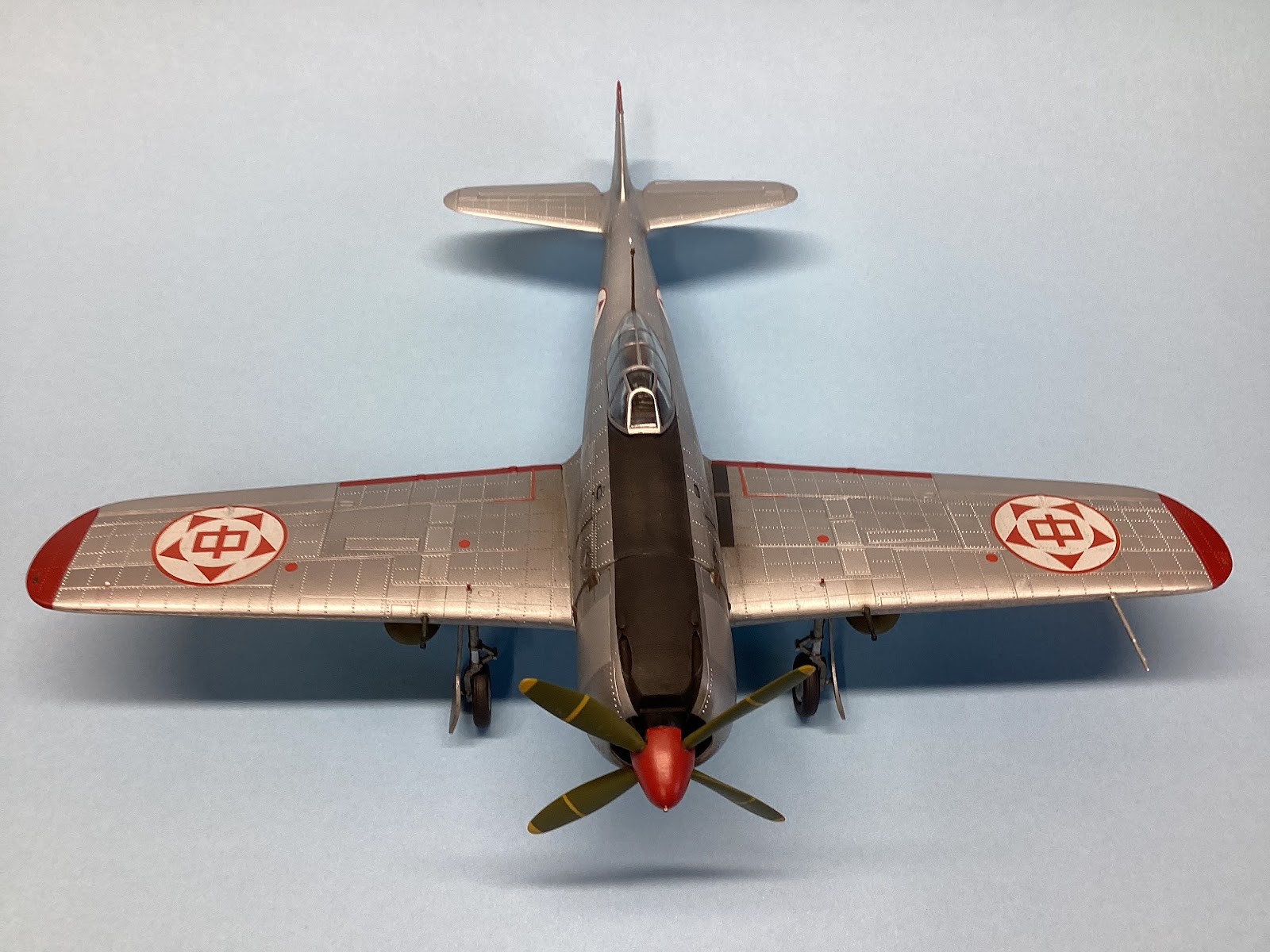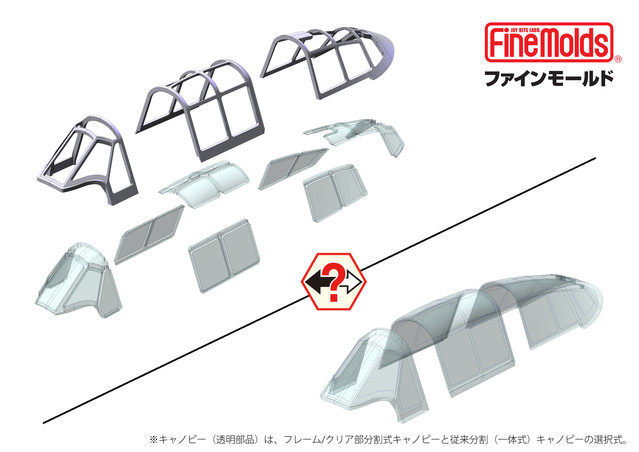McLents has kindly shared these images of his 1/48 scale Hayate in unusual Red Army of China Air Force markings, built from the 1973 vintage but still good looking Otaki kit (subsequently re-released by Arii in 1986). The RAF pilot figure from the 1/48 Tamiya Buffalo was included for scale but is a long way from Malaya!

Decals were from the Kora sheet NOT 48011 for a Hayate in 'Chinese Peoples Liberation Army Air Force' (PLAAF) markings whereas the insignia is actually that of the preceding Red Army of China Air Force in its nascent stage of utilising several ex-Japanese Army aircraft types. The insignia consisted of the character Zhōng (中middle - from middle country or China Zhōngguó 中國) within the points of a five-pointed star set on a red bordered white roundel. The possible use of Hayate by the RAoCAF is mysterious and the fate of those 104th Sentai Hayate captured and photographed by the Soviet Union murky. During one Nationalist Chinese F-5 photo Lightning sortie during the winter months of 1947/48 the pilot reported being pursued by two 'very fast' single radial-engined fighters. The F-5 was eventually able to outdistance the mysterious interceptors, one of which broke away fairly early whilst the other doggedly followed for many miles but was unable to gain. The first La-9 Russian fighters were not received by the PLAAF until late 1949. They had originally requested Yaks and considered the La-9 inferior to the P-51 Mustangs they had been using, of which more anon.

Photographs show a line-up of at least seven intact Hiko Dai 104 Sentai Hayate in Russian hands but they are not listed amongst the ex-Japanese aircraft recorded at the North-East Aviation School in Chinese communist use. There has been a deal of misinformation published about the 104th and the 25th Chutai. The latter is sometimes attributed with Ki-44 fighters but in fact operated the Ki-45, the Type 2 designation for both having been confused. The 25th originated in early 1944 as the 'Composite twin-seat Fighter Squadron' under the 15th Air Brigade HQ as part of the air defence at Anshan, Manchuria. The Composite title referred to the unit being composed of both Japanese and Manchurian personnel, the latter going on to operate the Ki-45 in their own units. The 25th was activated in August 1944 and based at Liaoyang whilst the 104th, activated in November 1944, was based at Anshan, both under 15th Air Brigade HQ.

There is a photograph of a Hayate in RAoCAF markings in 'Japanese Aircraft in Foreign Service' Vol.1 by Jacek Jackiewicz and Seweryn Fleischer, published by Atelier Kecay in 2012, and that can be seen in the review of that book here. The authors speculate that the photo is faked but it seems to be the basis of the Kora presentation. According to this book the Hayate were captured at Changchun airfield, also known as Dafangshen, which was later used as a training field by the Second Aviation Academy of the People's Liberation Army Air Force from the establishment of that force in 1949. However according to Japanese staff records the 104th ended the war at Anshan and Changchun was used as a Manchukuo Air Academy satellite training camp. The Hata, Izawa & Shores book also has the 104th at Anshan, with a Chutai detached to nearby Tanggangzi. That might be a confusion for an earlier deployment of a Type 4 fighter 'squadron' (later air regiment) at Anshan with a Type 4 'platoon' detached to Choushuitzu for the air defence of Dairen (Dalien) in October 1943. That would appear to be the nascent 104th Sentai being built up from Chutai to Sentai strength at the end of 1944. Choushuitzu was subsequently identified by the CIA as a Soviet operated airfield in 1948 (diagram shown below).

Minoru Akimoto recorded that the 104th was organised at Ozuki (Shimonoseki, Yamaguchi Prefecture, Japan) in August 1944 with secondary organisation completed by 30 November 1944 and based at 'Fen Tian' (Fengtian) and Anshan.
The North-East Aviation School at Tonghua, Jilin Province, was one of three PLAAF roots initiated in October 1945 when the Chinese Communist Party (CCP) sent a team into Manchuria to establish a flying school and to secure Japanese aircraft. By the end of the year about 120 aircraft had been collected at Tonghua of which only about 40 could be deemed operable. The majority were Tachikawa Ki-55 'Ida' advanced trainers from the Japanese Dai 5 Kyoiku Hikotai, Dai 23 Kyoiku Hikotai and the Air Academy. In addition members of Dai 26 Kyoiku Hikotai commanded by Maj Hayasi Yuichiro, a training unit engaged in advanced flying instruction for officers, including Maj Yuichiro himself, agreed to remain in China to assist in the refurbishment and maintenance of the aircraft and in flying instruction, many of them not returning home until 1956. All these units were under the command of the 101st Air Training Brigade.
According to Lü Liping ('The Road To The Sky', 1989) the 26th supplied 46 aircraft, 17 pilots, 96 ground crew and 188 other personnel. Japanese staff records list the unit as operating 20 Type 1 fighters (Ki-43) and 50 Type 2 Advanced Trainers (Ki-79), with 40 officers, 95 NCOs and 495 enlisted personnel about 10 August 1945. In fact the aircraft were captured and collected from various locations in North-East China. In addition to 30 Ki-55 advanced trainers of which six required repair the Tonghua School had three Kawasaki Ki-45 Toryu 'Nick' fighters, four Nakajima Ki-43-II Hayabusa 'Oscar' fighters, of which three required repair and two Mitsubishi Ki-46 'Dinah' recce aircraft. Three Ki-44 Shoki fighters were also listed although there are no known photos of them in communist hands. Ki-84 Hayate fighters are not listed amongst the ex-Japanese aircraft at Tonghua. Initially used for air combat training with the Ki-43s, the Ki-45s and one Ki-46 later formed the 1st Squadron of the RAoCAF Air Combat Group. The Ki-46 was operated as a 'fighter' and reportedly armed but the details of armament are unknown. It was intended to use the Ki-43s as fighter bombers together with the P-51s to support the crossing of the Yangtze river in 1949 but the support operation was cancelled as circumstances changed.
The other two roots of PLAAF aviation were secondly the Xinjiang connection where the CCP established a military academy at Dihua, the capital, in May 1937. The local warlord
Sheng Shicai, sponsored by the Soviet Union, established a flying programme at Dihua which included 43 Red Army personnel selected for training as pilots under Russian instructors. These students were taught on U-2 trainers, moving on to I-15 and I-16 fighters. Xinjiang operation of the I-16 has been discussed
here. The communist presence at Dihua was ultimately purged when Sheng threw in his lot with Chiang Kai Shek and the Nationalists but a proportion of the trained pilots subsequently made their way to Tonghua and joined the North-East Aviation School. The third root of the PLAAF was an aviation engineering school established in 1941 in Yan'an, the HQ of the CCP from 1935 to 1947, which taught aviation theory, engineering and armament but without any aircraft. The only future PLAAF pilot to graduate from this school was
Liu Yüri who went on to claim ace status flying the MiG-15 during the Korean War. Yan'an was also the main destination for defecting RoCAF personnel who, by June 1949, had flown in with 20 aircraft including a Ki-54 and B-24, and 54 pilots.
The first P-51 Mustangs were mainly acquired through defections and formed the 2nd Squadron of the Air Combat Group, but by October 1949 113 aircraft, 1,278 engines, over 4,000 tons of equipment and 2,267 aviation personnel had been acquired by the communists. In May 1949 six Mustangs had formed an air defence flight over Beijing after attacks by Nationalist B-24 bombers. A total of 21 are recorded as captured, of which 11 required repair. Nine of the P-51s performed a formation flypast over Tienanmen Square in Beijing for the first national parade of the communists on 1 October 1949. Reluctantly replaced with the Soviet La-9 in 1950 the P-51s served as fighter trainers at the Aviation School until 1953.
References
Red Wings Over The Yalu by Xiaoming Zhang, Texas A & M University Press, 2002
Military Aircraft in the Chinese Civil War, Taipei, 1992
Japanese Monograph No.151 Air Operations Record Against Soviet Russia, Lt Col Katsuo Sato, Staff Officer, Second Air Army, 1952
Image credit: All model photos © 2024 McLents; Decal set © 2017 Kora Models; Choushuitzu diagram via net















